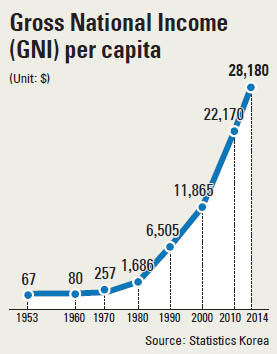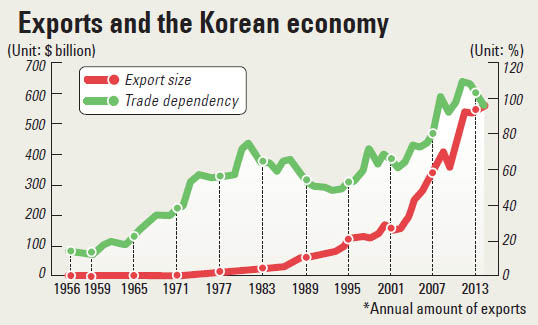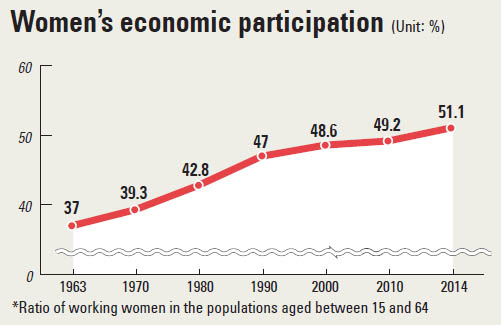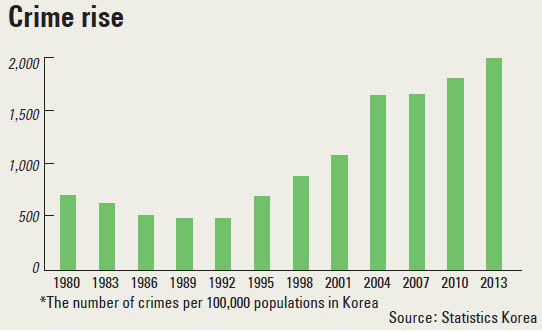Economic report card released for Korea’s 70th

It also detailed the flip side of the Miracle on the Han, including South Korea’s towering suicide rate - the highest in the developed world - and the rising tides of divorce and crime.
The nominal gross domestic product of Asia’s fourth-largest economy, which was one of the world’s poorest countries, stood at 1,485 trillion won ($1,277 billion) as of 2014, skyrocketing from 47.7 billion won in 1953, after the 1950-53 Korean War devastated the country.
According to World Bank data, there are only 15 countries in the world that record more than 1 trillion won in nominal GDP, and Korea ranked 13th.

On average, the South Korean economy grew 7.3 percent annually between 1953 and 2014, including average growth of about 9.7 percent between 1961 and 1991. After 2000, growth slowed, settling at around 4 percent annually.

Accordingly, Korea’s dependence on trade has grown huge. In 1956, the ratio of exports, imports and all kinds of overseas income in the total GNI stood at only 15.2 percent. That figure grew to 99.5 percent as of 2014.

As a result, agriculture and fisheries accounted for only 2.3 percent of total industrial output in 2014, diminishing from 48.2 percent in 1953.
Meanwhile, manufacturing grew to 30.3 percent in 2014 from 7.8 percent in 1953, and services accounted for more than half of industrial output, 59.4 percent last year, from 40.3 percent in 1953.

In finance, Korea also improved its debt ratio and foreign exchange reserves. Debt in Korea’s manufacturing sector once reached its peak of 396.3 percent of total assets in 1997, when Korea was struggling with the Asian financial crisis, but it fell to 92 percent in 2013.
Foreign exchange reserves also rose to 25.8 percent of total GDP in 2014, from 3.7 percent in 1997.
In the labor market, more Korean women are working. The ratio of working women out of the total “economically active” population between ages 15 and 64 rose to 51.1 percent in 2014, from 37 percent in 1963.
Working conditions in manufacturing also improved. Average working hours for the industry fell to 186.7 per month in 2014, from 232 hours in 1970.
Still, annual working hours for Korean workers stood at 2,071 hours on average, longer than in other developed countries, with 1,312 in Germany, 1,400 in France and 1,795 in the United States.
And despite economic growth, Korea has lagged in organized labor development.
In 1977, about a quarter of Korean companies had unions, but the rate dropped to merely 10 percent in 2013. That rate was below many developed countries, such as 91 percent in Sweden and even 16 percent in Japan and 13 percent in the United States.
Dramatic economic development brought negative effects. More Koreans are committing suicide than before, from 8.7 people per 100,000 in 1983 to 28.5 per 100,000 in 2013. The 2013 record is the highest figure among OECD countries.
More Koreans are also choosing to have smaller families, divorce or live alone from the start.
The ratio of single-person households rose to 23.9 percent in 2010 from only 9 percent in 1990. The average number of family members per household also dropped to 2.7 in 2010, from 5.4 in 1952. The number of divorced couples per 1,000 people rose to 2.3 in 2014, from 0.4 in 1970.
Over the past three years, the number of crimes rose from 935 in 1981 per 100,000 to 2,039 in 2012.
“The suicide rate started to surge after the 1997 Asian financial crisis,” said Jeong Jin-wook, an associate research fellow at the Korea Institute for Health and Social Affairs, by phone. “Suicides by elderly people living alone also rose, which is seen in other developed countries such as Japan.”
BY KIM HEE-JIN [kim.heejin@joongang.co.kr]










with the Korea JoongAng Daily
To write comments, please log in to one of the accounts.
Standards Board Policy (0/250자)